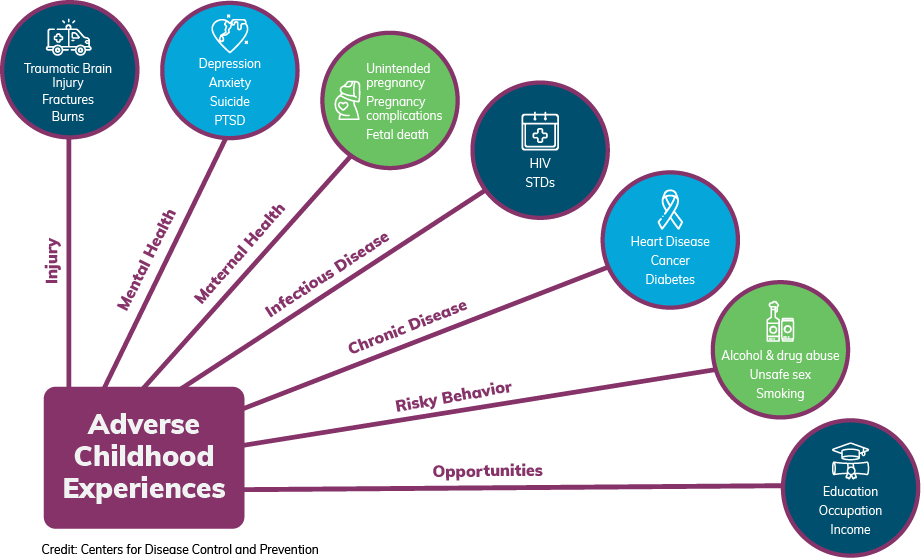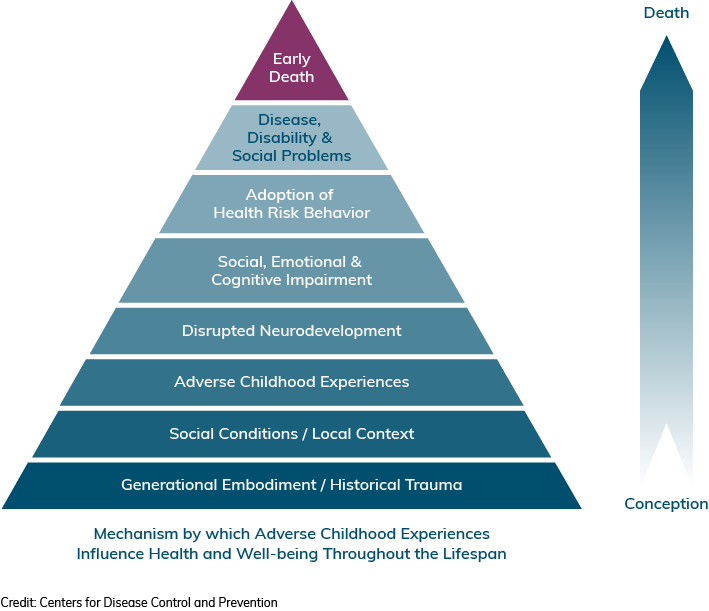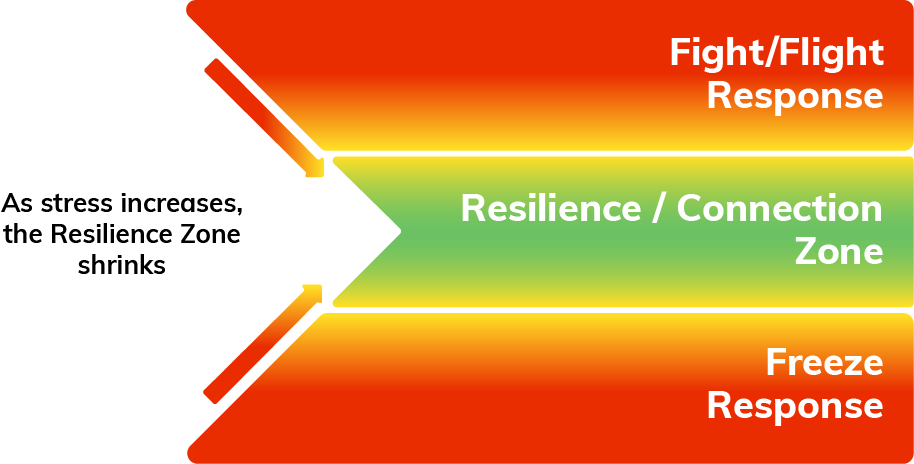What are ACEs?
“ACEs” stands for Adverse Childhood Experiences or Adverse Community Environments
Study after study shows that exposure to ACEs (such as abuse, neglect, violence, and poverty – to name a few risk factors) cause toxic stress and can lead to significant health, behavioral, and societal issues.
ACEs are Adverse Childhood Experiences. The term comes from a 1998 study by Kaiser Permanente and the Centers for Disease Control (CDC), which studied 17,000 people to better understand how abuse, neglect, and household dysfunction during childhood affect adult health outcomes and behaviors. While we’ve always had a hunch that there’s a connection between childhood stress and trauma (a high ACE score) and adult struggles (not just health- moods and relationships, too), we now have the science of ACEs to explain its reach.
The study established a framework for viewing behaviors as adaptive responses to stress. In other words, behaviors are symptoms, and symptoms can become habits. The study also found that ACEs are really common, tend to occur together, and are risk factors for a number of health and behavioral outcomes. In fact, people with four or more ACEs face significantly higher risk for seven out of the ten leading causes of adult death, including heart disease, stroke, cancer, COPD, diabetes, Alzheimer’s, and suicide.
While this original study was a powerful starting point, it was limited in many ways. The participant pool was mostly white, college educated, middle class, and covered by health insurance. The study also didn’t look at other sources of adversity, like community violence, poverty, and inter-generational trauma.
To build on the original study, the Building Resilience Initiative expanded the understanding of ACEs to include both Adverse Childhood Experiences and Adverse Community Experiences. The RYSE Youth Center also expanded this framework to acknowledge the impact of intergenerational trauma.
Want to build resilience, address the root causes of the challenges we’re experiencing, and achieve higher quality outcomes? Understanding that adversity affects all of us and the people we serve helps us peel back the onion and get to the core so we can.
Click here to learn more about the original study.
Interested in taking the ACE survey?
What is resilience?
Resilience is the ability to come back into connection during times of stress.
Our resilience can be affected when we have frequent or long exposure to toxic stress from ACEs, especially when we don’t have protective factors to act as our “adversity buffer.”
There are several types of stress that affect our brains, bodies, and resilience. The Center on the Developing Child at Harvard University describes three types: positive, tolerable, and toxic stress.
Positive Stress
Positive stress can be motivating. It can get us out of bed in the morning and can help us prepare for a test or meet a deadline. It is a typically a short term feeling that might activate our body to spring out of bed or to run away from something that is dangerous. It might help us focus on a task we need to complete or on a potential dangerous person in a crowd. While we may feel nervous or anxious, these feelings are short-lived and appropriate for the situation.
Tolerable Stress
When we experience tolerable stress, we might notice that we sweat more and we can feel our heart race. We might feel uncomfortable in our bodies. As stress hormones increase, we experience more intense physical and emotional reactions than we do with positive stress. Tolerable stress is short-lived, but if it happens frequently or over a long period of time, it may develop into toxic stress.
Toxic Stress
Toxic stress occurs when we are overwhelmed by exposure to adversity or stress without protective buffers in place. Due to the cumulative effects of exposure to stress, a person can develop toxic stress physiology as a result of a single intense experience, shorter and more frequent episodes, or even small doses of exposures over time. This means that although a person could have exposure to lots of adversity, with protective factors in place, their ACEs are not their destiny!
In addition to different types of stress, we each have different windows of tolerance, which dictate if and how we handle stressors.
The goal is to stay in the “Connection Zone,” where we can think clearly, make intentional choices, communicate, and connect with others. When our bodies perceive fear and we feel unsafe, we often get pushed outside our Connection Zone. In those moments, our only priority is to survive, so we have an adaptive response: fight, flight, or freeze.
Extended exposure to toxic stress from Adverse Childhood Experiences, Adverse Community Experiences, or intergenerational trauma can make someone’s Resilience Zone smaller, leading to more fighting, fleeing, and freezing. To build up our “resilience muscle” so we can respond better to stress and achieve higher quality outcomes, we must increase our awareness of when we’re inside and outside of our Resilience Zone. That way, we can practice skills to get ourselves back into the zone and reconnect with the thriving world.
Want to learn more about resilience?
What is a trauma-informed approach?
A trauma-informed approach is a framework for addressing the origins of an issue, achieving higher quality outcomes, and breaking the cycle of intergenerational trauma.
When we apply a trauma-informed approach, we realize the symptoms ACEs can cause, dig deeper to recognize the root causes of these symptoms, and respond to build more resilient organizations and communities.
A trauma-informed and resilience-building approach assumes that our own behavior and the behavior of others are adaptive — that there’s a root cause behind everything so that we can be accountable for our actions. In Ellen Degeneres’ Netflix special, “Relatable,” she sums it up best when she talks about slow drivers: “You don’t know why someone’s going slow. You have no idea. Maybe they’re transporting a bowl of soup!”
While this is a light-hearted example, it shows the connection between understanding why we do what we do and the impact of ACEs, resilience, and a trauma-informed approach.
The science behind the ACEs framework helps us understand WHAT causes toxic stress and trauma, as well as WHY we feel and behave the way we do. A trauma-informed approach is HOW we address those challenges to minimize further damage, build resilience, and achieve higher quality outcomes.
“Trauma” is a word that comes with a lot of misconceptions and baggage.
Trauma comes in many forms, some more obvious than others. It could happen due to homelessness and job loss, refugees seeking asylum, gun violence, drugs, neglect, conditional attachment, and so much more. These experiences don’t necessarily cause trauma; the toxic stress these experiences create does.
But it’s not about playing the “trauma olympics” and comparing who has experienced the most or the worst trauma. It’s about working toward healing ourselves, our communities, or our colleagues. It isn’t an excuse for “bad” behavior.
Healing starts with healthy relationships. YOU have the knowledge and power to build healthy relationships and facilitate the healing process. That’s where a trauma-informed approach comes in.
You can apply a trauma-informed approach to decrease toxic stress and increase resilience in any setting and throughout all levels of an organization or community, from how employees are managed, to how policies and procedures are written and implemented, to how a physical environment is designed.
For example:
- A trauma-informed non-profit might use restorative practices to handle conflict resolution among staff and board members.
- A trauma-informed pediatric clinic might integrate screening tools to identify and address trauma among patients and use those findings when considering diagnoses and treatments.
- A trauma-informed school might integrate mindfulness and yoga into its classrooms to help students learn tools to self-regulate.
These are all examples of specific, trauma-informed actions that treat behaviors as symptoms, dig deeper to uncover the root cause, and support healing.
Get Started
Want to learn the basics about ACEs and a trauma-informed approach? Know what they are, but not sure what to do next? We’re here for you. Contact us to get started today and learn how our coaching, tools, and guidance can support you on your journey.









